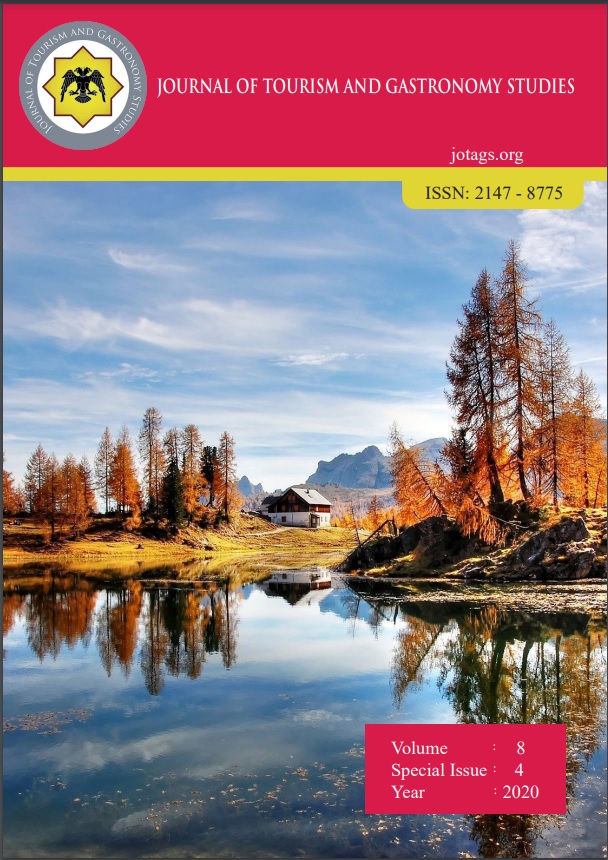Gastronomide Güncel Bir Yaklaşım- Nörogastronomi: Science Direct Veri Tabanında Yayınlanan Makaleler Üzerine Bir İnceleme (A Current Approach to Gastronomy- Neurogastronomy: A Review of the Articles Published in Science Direct Database)
DOI:
https://doi.org/10.21325/jotags.2020.677Keywords:
Gastronomy, Neurogastronomy, Sense, Taste and flavorAbstract
Neurogastronomy seeks to understand complex brain processes that simply help to understand what is eaten, how and why. It is thought that studies on the subject since 2006, when the concept emerged, are relatively limited. From this point of view, the aim of the study is to make a situation assessment by presenting examples from scientific research and applications about the concept of neurogastronomy, its development, the elements that make up the taste perception and what neurorogastronomy can change in the field of gastronomy, through the articles published in the Science Direct database. The data set of the study consists of articles with the themes of "multi-sensory experience", "taste science and gastronomy" and "neurogastronomy" in the title and content - in order to see the development of the concept of neurogastronomy in the field more clearly - between 1994 and 2019. In those years, 380 studies were published on the multi-sensory experience theme, 853 studies were published on the theme of taste science and gastronomy, and 20 studies were published on the theme of neurogastronomy. A bibliometric analysis was carried out in order to determine the tendency of the subjects dealt with within the scope of the research over the years and which subjects were mostly concentrated. In the studies in the database; The inclusion of subjects such as neurogastronomy, molecular gastronomy, and gastrophysics, especially after 2006, reveals a new perspective to the field of gastronomy. The most emphasized topics and other themes in terms of neurogastronomy; smell and taste, flavor molecules, flavor formation, human brain and flavor system, taste and emotions, smell-flavor and language.
References
Atlam, D. (2015). Nörogastronomik Sofra, Forbes Life, 156-159
Baral, S. (2015). Neurogastronomy 101: The Science of Taste Perception. Retrieved from https://www.eater.com/2015/10/19/9553471/what-is-neurogastronomy
Castellanos, L. (2016). Nörogastronomi Nörogastronominin Yaratıcı Dahisi, PAXadvisor, http://dergi.paxadvisor.com/trend/norogastronomi/, Erişim Tarihi: 16.03.2019
Doty, R. L. (2012). Has Human Olfaction Evolved Primarily to Provide Flavor to Foods?. Trends in Neurosciences, 35(2), 79-80.
Firger, J. (2016). Brain Food: How neurogastronomy will soon alter your perception of flavor; making food palatable for people with taste loss takes the genius of both neuroscientists and top-notch chefs. Newsweek, (17).
Harrar, V., Spence, C. (2013). The Taste of Cutlery: how the taste of food is affected by the weight, size, shape, and colour of the cutlery used to eat it. Flavour, 2-21.
Herz, S. R. (2016). Birth of a neurogastronomy nation: The inaugural symposium of the International Society of Neurogastronomy. Chemical Senses, 41: 101-103
International Society of Neurogastronomy (2018). Retrieved from http://isneurogastronomy.org/about-us
Kanwal, K.J. (2016). Brain tricks to make food taste sweeter: How to transform taste perception and why it matters. Retrieved from http://sitn.hms.harvard.edu/flash/2016/brain-tricks-to-make-food-taste-sweeter-how-to-transform-taste-perception-and-why-it-matters/
Konnikova, M. (2016). Altered tastes. 36-45, Retrieved from https://newrepublic.com/article/128899/man-will-transform-eat
Kpossa, M. & Lick, E. (2020). Visual merchandising of pastries in foodscapes: the influence of plate colours on consumers’ flavour expectations and perceptions. Journal of Retailing and Consumer Services, 52.
Kurgun, H. (2017). Gastronomi trendleri milenyum ve ötesi. Ankara: Detay Yayıncılık
Kurgun, O. A. (2016). Gastronomide trendler. İçinde Kurgun, H., Bağıran Özşeker, D. (Ed.), Gastronomi ve turizm, Ankara: Detay Yayıncılık.
Lahne, J. (2013). Neurogastronomy: how the brain creates flavors and why it matters: by Gordon M. Shepherd, Food, Culture & Society, 16:2, 327-330
Loss, C. (2011). Scent and sensibility. Nature, 480, 176-177
Neville, T. (2011). Shepherd, Gordon M.: Neurogastronomy: how the brain creates flavor and why ıt matters. Library Journal, (19), 94
Paktin, S., Patır, H. (2018). Çoklu duyusal deneyim: insan hissettiklerini asla unutmaz, gasterea. Retrieved from http://gastereamag.com/coklu-duyusal-deneyim-insan-hissettiklerini-asla-unutmaz/
Perry, A., & Dawahare, L. (2015). Neurogastronomy symposium begins pursuit of solutions for the taste impaired. University of Kentucky news food, Flavor and Science.
Wein, H. (2015). How taste is perceived in the brain. Retrieved from https://www.nih.gov/news-events/nih-research-matters/how-taste-perceived-brain
Yaparel, C., Elmacı, Y. (2016). Tat-koku interaksiyonları, Akademik Gıda, 14(2), 218-224
Yıldırım, A., Şimşek, H. (2006). Sosyal bilimlerde nitel araştırma yöntemleri, Seçkin Yayınevi, Ankara
Downloads
Published
How to Cite
Issue
Section
License
Copyright (c) 2023 Journal of Tourism & Gastronomy Studies

This work is licensed under a Creative Commons Attribution-NonCommercial 4.0 International License.








